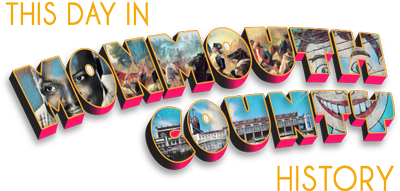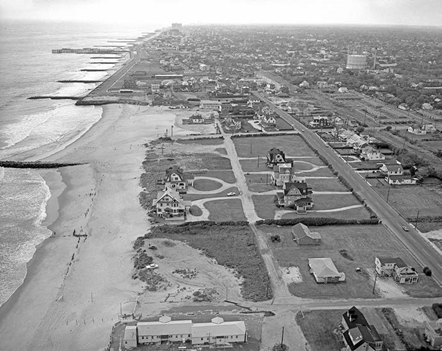By Randall Gabrielan
Editor’s note: On May 19, 1887, the Monmouth Inquirer of Freehold published a list of “New Incorporations” filed with the county clerk’s office, which included the following:
Buffalo Bill’s Wild West Company. Office at Long Branch. William F. Cody, North Platte, Neb; Nathan Salsbury and Frank C. Naeder, Long Branch; Milton E. Milnor, Fort Benton, Montana, and William D. Guthrie, New York city [sic], incorporators. Capital stock $500,ooo. Filed February 12, 1887.
The incorporation in Monmouth County, and Cody’s long record of performance in Long Branch, have linked him via rumor to Salsbury’s major residential construction project. The record does not support the rumor. Here is the real story, reprinted by permission from Lost Monmouth County, the new book by Randall Gabrielan. Read the Monmouth Timeline review of this new book here.
THE RESERVATION
Nathan Salsbury found a home in Long Branch during his long, peripatetic career on the entertainment circuit. After he retired, he built a spectacular housing colony on the waterfront. Nearly all of it vanished.
Salsbury, born in 1846 in Rockport, Illinois, joined the Union army while a teen, initially as a drummer boy, but later as a combatant with the Fifteenth Illinois Volunteer Infantry and the Eighty-Ninth Illinois Regiment of Infantry. He saw action in a number of campaigns and suffered wounds at Chickamauga that General Howard Porter thought were fatal. Two decades later, General William Tecumseh Sherman recalled Salsbury as a participant in the Atlanta campaign. An engaging personality, Salsbury also sang, danced and played cards during his service time, when he also honed his skills for promotional zeal and exaggeration that included a claim of his return to civilian life with an unbelievable sum of poker winnings.
After the Civil War, Salsbury displayed his acting talents in Grand Rapids, Michigan, and secured a number of short-term gigs on various stages prior to landing a four-year run as a comedian at the Boston Museum. In the 1870s, Salsbury attained renown with the Salsbury Troubadours, a company formed in conjunction with John Webster.
Salsbury met William F. Cody in the early 1880s, an encounter that led to the major work of the Salsbury career, the promotion-management of the Buffalo Bill Wild West Show. While Cody was responsible for the vaudeville stage re-creations and reminiscences of his exploits in the unsettled West, management by Salsbury made the show an international success.
Numerous European venues included the Vatican and Windsor Castle. Salsbury’s long and often contentious relationship with Cody became breached in the 1890s with litigation that extended beyond Salsbury’s death.
Salsbury produced one more exotic show, Black America, spectacular in his time, racist in ours. The Times headline of the May 25, 1895 opening tells more than one can embrace now: “Wild Negro Chants and Dances/In ‘Black America’ Brooklyn, May Be Seen the Fun-Loving Darky of Old Slavery Days.” Ironically, the show opened at Ambrose Park, South Brooklyn, where, during the prior year, the Wild West Show had been performed. The show was later mounted at Madison Square Garden.
The well-traveled Salsbury sought permanent abodes that included 30 West 96th Street, New York, and a summer place at Long Branch. Frank Meador, his manager, attracted him to the shore, where the pair had adjoining houses that were located at 321 and 323 Liberty Street. Neither is extant, and no image is known to have survived. Property records demonstrate that Salsbury did not own 311 Liberty Street, despite persistent claims that he did. The appeal of Long Branch inspired Salsbury to plan a magnificent waterfront housing colony as retirement approached. He bought in 1900 a sixteen-and-two-thirds-acre tract in North Long Branch where the East End Hotel formerly stood, land that possessed a long, even notorious history. Alexander M. Cristalar had erected a building in 1862, initially called the Atlantic Hotel and later the Arlington House, but the East End, after damage in an 1880 storm, was razed the next year. The vacant land was later owned by John Hoey, who failed to build a planned hotel, and by Jay Gould, among the most evil of nineteenth-century crooks, one who is inexplicably celebrated by some local historians as a famous Long Branch visitor.
The plot was laid out in fourteen lots along Ocean Avenue that were bisected by a private street called the “The Trail.” Plans were made to construct eleven houses, but only nine were built. Salsbury named his development the Reservation during a time when most indigenous residents in the decreasingly wild west were herded into reservations. Salsbury’s choice of Native American names reflected his respect for the Indians. Either tribes or individuals, they are: No. 1, Cheyenne; No. 2, Iroquois; No. 3, Navaho; No. 4, Arapahoe; No. 5, Uncaspapa; No. 6, Okalhofee; No. 7, Cherokee; No. 8, Okelsska; and No. 9, Miami. Salsbury chose Leon Cubberley (1875–1968) as architect. After the young practitioner opened his Long Branch office in 1896, he soon executed for Salsbury what would represent the architect’s most ambitious residential project. Cubberley’s designs embraced Queen Anne and Stick Style motifs. Investment income motivated Salsbury to build, but his enjoyment of the fruits of his labor was brief. In gradually fading health but having been laid up for only a week, Salsbury died in Long Branch on December 24, 1902. His body was removed to New York for a funeral and interment at Woodlawn Cemetery in the Bronx. He had appointed Rachel as sole heir with the confidence that she would respond to their children’s needs. She retained the Reservation for two decades prior to selling the last parcel in 1920. Elements that long buffeted the shore battered the exposed Reservation, leading to its gradual deterioration. The circa 1960s aerial view of the Reservation depicts the few remaining houses along the private street, “The Trail.” Courtesy of Dorn-Severini Classic Images.
While details on individual losses is beyond the ambit of this work, by the early 1970s, the land of the faded Reservation was primed for public use, despite six owner-occupied houses remaining, with all or most owners desiring to retain their properties. An underfinanced City of Long Branch acquired the property and opened a public park. A declaration of eligibility for the National Register of Historic Places was obtained as a consequence of unfounded perceptions of association with Cody. Rumors of residence, even investment, there by Cody and the presence of Wild West performers had become rife. After wrangling among interested parties, the tract was acquired in 1983 by Monmouth County. The county was better funded to secure the potential of the land, although it lacked interest or the mission to preserve deteriorated houses. The Navaho Lodge, the only one salvageable, was adapted as headquarters for the Seven Presidents Oceanfront Park of the Monmouth County Park System. This beachfront park on the former Reservation is the most heavily visited site in the system
Randall Gabrielan began his second career as a local historian during the 1980s while engaged as an insurance broker, a spell during which he wrote articles, delivered his first talks, mounted museum exhibitions and began a long tenure as president of the Middletown Township Historical Society. In the 1990s, Gabrielan published the first of his many books, titles primarily on Monmouth County subjects, but also elsewhere in New Jersey and New York City. In 2000, he began a thirteen-year run as executive director of the Monmouth County Historical Commission, a body he now serves as vice-chair. Gabrielan and his wife, Carol Stout, live in Middletown.

Sources:
Gabrielan, Randall. (2009). Long Branch, NJ: Reinventing a Resort. Schiffer Publishing, Atglen, Penn., 2009.
Nate Salsbury’s New Reservation. (1900). Long Branch Record, Long Branch, N.J., August 31, 1900, P. 1.
Nathan Salsbury One of the Best-Known Showmen in the World. (1900). The Successful American, Vol. 1, No. 5, May, 1900.
New Incorporations. (1887). The Monmouth Inquirer, Freehold, N.J., May 19, 1887, P. 1.
Image of The Reservation courtesy Randall Gabrielan. Image of the Navaho house courtesy John R. Barrows.


Leave a Reply